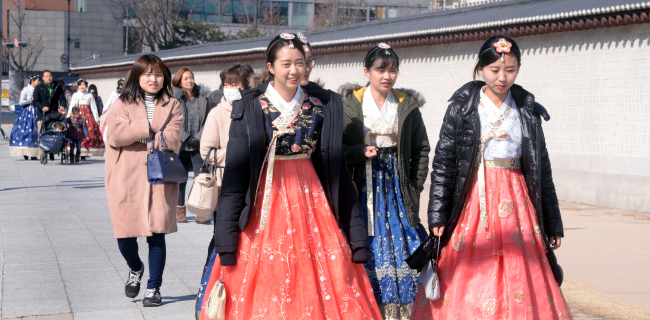Gwanghwamun is the largest main gate of Gyeongbokgung Palace in the center of Seoul. Constructed in 1395, the gate was destroyed and rebuilt multiple times over the past several hundred years of history and was finally restored as it is in 2010.
In the front of the gate is the Gwanghwamun Square that was redesigned to open to the public in August 2009. The backdrop of the traditional wooden palace and Bukak Mountain on one side and tall modern buildings surrounding the area on the other, Gwanghwamun’s mixed scenery reflects the Korean society where old and new cultures coexist.




Office workers and curious travelers on the wide busy crossroads of Gwanghwamun add to the bustling view of the heart of the city. Young and old palace visitors can also be spotted wondering on the streets wearing the nation’s traditional costume Hanbok.
In the center of the square stand two statues, of King Sejong the Great and Admiral Yi Sun-shin of the Joseon Dynasty in the 1400s, who remain as two of the most popular historical figures and exemplars of conduct in the country.




Gwanghwamun was once the core of administrative politics and stands as the symbol of nation’s democracy to foster diverse voices of South Korea -- daily rallies and protests can be seen in one corner of the open space.
In the wake of the massive corruption scandal which led to the ouster of the former and now jailed President Park Geun-hye at the end of 2016, the city center was filled with tens of thousands of citizens who took to the streets holding candles, to make their voice heard against injustice.
Photo by Park Hyun-koo (
phko@heraldcorp.com)
Written by Jo He-rim (
herim@heraldcorp.com)












![[KH Explains] For Korean automakers, Chinese EVs may loom larger than Trump’s tariffs](http://res.heraldm.com/phpwas/restmb_idxmake.php?idx=644&simg=/content/image/2024/11/14/20241114050537_0.jpg)
![[Graphic News] Tainan predicted top destination for South Koreans in 2025](http://res.heraldm.com/phpwas/restmb_idxmake.php?idx=644&simg=/content/image/2024/11/13/20241113050807_0.gif)

![[Herald Review] Cho Seung-woo takes 'Hamlet' crown](http://res.heraldm.com/phpwas/restmb_idxmake.php?idx=644&simg=/content/image/2024/11/14/20241114050593_0.jpg)